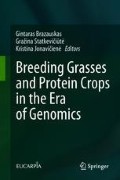Abstract
As ruminant species diversify in natural and managed ecosystems in an effort to increase production, so does the need for greater plant diversity. Legume shrub propagation is rarely targeted for this purpose. As an example, the wide range of native perennial, shrub (0.5–3 m) legumes in Texas indicates untapped potential for multiple uses such as forage, ecosystems services, wildlife habitat, fuel, and possibly pulse crops. We propose that concerted programs to identify, collect, characterize, domesticate and commercialize these legumes could lead to multiple benefits in native and cultivated ecosystems characterized by herbaceous, shrubby and arboreal canopies, each contributing to greater herbage and animal productivity than mono-canopy systems. This approach could be applied in Europe and throughout the world.
Access this chapter
Tax calculation will be finalised at checkout
Purchases are for personal use only
References
Correll DS, Johnston MC (1970) Manual of vascular plants of Texas. Texas Research Foundation, Renner
Dubeux JC Jr, Lira MA, dos Santos MVH, Muir JP, de Barros DAGM, da Silva MA, Teixeira VI (2014) Soil characteristics under legume and non-legume tree canopies in signal grass (Brachiaria decumbens Stapf.) pastures. Afr J Range Forage Sci 31:37–42
Diggs GM Jr, Lipscomb BL, O’Kennon RJ (1999) Shinners & Mahler’s illustrated flora of North Central Texas. Botanical Research Institute of Texas, Fort Worth
Dittus D, Muir JP (2010) Scarification of native Texas legume seeds. Native Plants J 11:5–10
Estell RE, Havstad KM, Cibils AF, Anderson DM, Schrader TS (2014) The changing role of shrubs in rangeland-based livestock production systems: can shrubs increase our forage supply? Rangelands 36(2):25–31
Hofmann RR, Stewart DRM (1972) Grazer or browser: a classification based on the stomach structure and feeding habits of East African ruminants. Mammalia 36:226–240
Kulakow PA, Benson LL, Vail JG (1990) Prospects for domesticating Illinois bundleflower. In: Janick J, Simon JE (eds) Advances in new crops. Timber Press, Portland, pp 168–171
Lehman RL, O‘Brien R, White T (2005) Plants of the Texas Coastal Bend. Texas A&M University Press, College Station
Muir JP, Pitman WD, Foster JL, Dubeux JC Jr (2015) Sustainable intensification of cultivated pastures using multiple herbivore species. Afr J Range Forage Sci 32:97–112
Nair PK, Fernandes ECM, Wambugu PN (1984) Multipurpose leguminous trees and shrubs for agroforestry. Agroforestry Syst 2:145–163
Noah RL, Muir JP, Brady JA, Wittie RD, Kattes DH, Pitman WD, Rea GL, Brakie MR (2012) Genotypic and phenotypic variability in three prairie acacia accessions. Crop Sci 52:951–959
Provenza FD, Villalba JJ, Dziba LE, Atwood SB, Banner RE (2003) Linking herbivore experience, varied diets, and plant biochemical diversity. Small Ruminant Res 49:257–274
Sanderson MA, Goslee SC, Soder KJ, Skinner RH, Deak A (2007) Plant species diversity, ecosystem function and pasture management—a perspective. Can J Plant Sci 87:479–487
Smith FS, Lloyd-Reilley J, Ocumpaugh WR (2010) South Texas Natives: a collaborative regional effort to meet restoration needs in south Texas. Native Plants 11(3):252–268
Sorensen JS, Skopec MM, Dearing MD (2006) Application of pharmacological approaches to plant-mammal interactions. J Chem Ecol 32:1229–1246
Turner BL (1959) The legumes of Texas. University of Texas Press, Austin
Vines RA (1960) Trees, shrubs and woody vines of the southwest. University of Texas Press, Austin
Warren LE, Uekert DN, Shelton JM (1984) Comparative diets of Rambouillet, Barbado, and Karakul sheep and Spanish and Angora goats. J Range Manage 37:172–180
Author information
Authors and Affiliations
Corresponding author
Editor information
Editors and Affiliations
Rights and permissions
Copyright information
© 2018 Springer International Publishing AG, part of Springer Nature
About this paper
Cite this paper
Muir, J.P., Forrest, F.S., Brady, J., Dubeux, J.C., Pitman, W.D. (2018). Domesticating Shrubby Native Legumes for Pastures and Natural Grasslands. In: Brazauskas, G., Statkevičiūtė, G., Jonavičienė, K. (eds) Breeding Grasses and Protein Crops in the Era of Genomics. Springer, Cham. https://doi.org/10.1007/978-3-319-89578-9_8
Download citation
DOI: https://doi.org/10.1007/978-3-319-89578-9_8
Published:
Publisher Name: Springer, Cham
Print ISBN: 978-3-319-89577-2
Online ISBN: 978-3-319-89578-9
eBook Packages: Biomedical and Life SciencesBiomedical and Life Sciences (R0)

